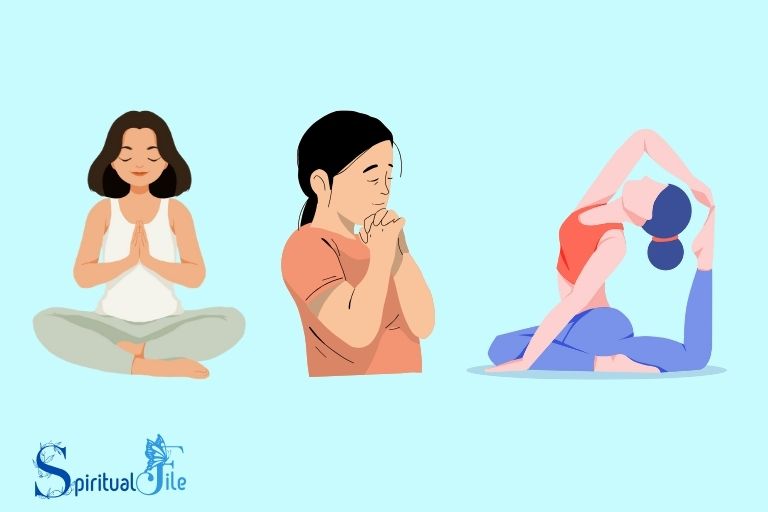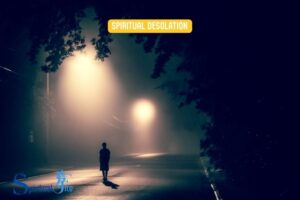Examples of Spiritual Practices: Develop, Meditation!
Spiritual practices are actions or habits that individuals perform to establish, develop, and foster a sense of connectedness with the divine, the self, others, and the environment.
Examples of spiritual practices include meditation, yoga, prayer, spending time in nature, contemplative reading, and performing acts of kindness.
Spiritual practices are personal routines or rituals that individuals undertake to cultivate a deeper sense of purpose, peace, harmony, and well-being.
They may be religious or non-religious in nature, and they typically involve activities that promote mindfulness, self-awareness, compassion, and connection to a higher purpose or power.
Each of these spiritual practices serves to deepen our connection with ourselves, others, the divine, and the world around us. They help us to cultivate mindfulness, compassion, and a sense of purpose and meaning in life. By integrating
10 Examples of Spiritual Practices
| Examples | Description |
|---|---|
| Prayer | Communication with a higher power or divine entity, often with the intention of worship or request. |
| Meditation | A practice where an individual uses a technique to achieve a mentally clear and emotionally calm state. |
| Yoga | A physical, mental, and spiritual practice that originated in ancient India. It involves a series of postures and breathing exercises. |
| Fasting | Refraining from eating for a certain period of time for spiritual or religious reasons. |
| Pilgrimage | A journey or search of moral or spiritual significance. It usually involves traveling to a holy or sacred place. |
| Self-reflection | The act of thinking about one’s own behaviors, values, and beliefs in order to foster personal growth or spiritual enlightenment. |
| Scripture study | Reading and contemplating on religious texts or writings. |
| Chanting | Reciting rhythmic phrases or prayers, either silently or aloud. |
| Mindfulness | The practice of focusing one’s mind on the present moment, often used as a form of meditation. |
| Altruism | The practice of selfless concern for the well-being of others, often seen as a spiritual virtue. |
Key Takeaway

Five Facts About Spiritual Practices
1. Meditation Techniques
Discover the power of meditation techniques to enhance your spiritual journey.
From mindfulness to transcendental meditation, explore various practices that promote inner peace and self-awareness.
Guided Meditation
- Guided meditation is a popular technique for beginners, as it helps individuals focus their attention and relax their minds. It involves listening to a guided meditation session, led by an experienced practitioner or through a meditation app.
- During a guided meditation, the instructor provides verbal instructions, helping you visualize certain scenes or scenarios to cultivate a sense of calm and presence.
- This technique is excellent for those who find it difficult to meditate on their own or prefer having guidance throughout the process.
- Guided meditation can be tailored to different intentions, such as reducing stress, improving sleep quality, or enhancing creativity.
- By following the instructions and visualization provided in guided meditation, individuals can develop a deeper connection to their inner self and experience a profound sense of peace.
Mindfulness Meditation
- Mindfulness meditation is a practice that involves focusing on the present moment and acknowledging one’s thoughts, feelings, and bodily sensations without judgment.
- This technique encourages individuals to observe their thoughts, emotions, and sensations as they arise and pass by, cultivating an attitude of non-reactivity.
- Mindfulness meditation can be practiced in various ways, such as focusing on the breath, body scan, or walking meditation.
- The goal of mindfulness meditation is to develop a heightened sense of awareness and maintain a non-judgmental attitude towards one’s experiences.
- By practicing mindfulness regularly, individuals can gain insight into their minds, reduce stress, and enhance overall well-being.
Transcendental Meditation
- Transcendental meditation ™ is a technique that involves repeating a specific mantra silently to oneself during meditation. This mantra is chosen individually based on its suitability to the practitioner.
- Tm is practiced for 20 minutes twice a day, while sitting comfortably with closed eyes.
- The purpose of tm is to reach a state of deep relaxation and transcend thought activity, accessing a state of pure consciousness beyond the conscious mind.
- Tm has been found to promote relaxation, improve clarity of mind, and reduce symptoms of stress.
- Though tm originally comes from the vedic tradition, it is now widely practiced by people from various religious and spiritual backgrounds.
Remember, spiritual practices, such as meditation techniques, can greatly enhance personal growth, promote self-awareness, and bring about a sense of inner peace.
Experiment with different techniques to find the ones that resonate with you the most.
2. Rituals And Ceremonies
Rituals and ceremonies play a significant role in spiritual practices.
From meditation and prayer to purification rituals and sacred ceremonies, these actions are examples of how individuals connect with their spirituality on a deeper level.
Rituals And Ceremonies
Rituals and ceremonies play a significant role in various spiritual practices, helping individuals connect with their inner selves and the divine.
These practices can provide a sense of grounding, peace, and spiritual growth. Let’s explore some examples of rituals and ceremonies commonly practiced in different spiritual traditions.
Prayer Rituals:
- Prayer rituals are a powerful way to communicate with the divine and express gratitude, seek guidance, or offer intentions.
- They often involve setting aside a specific time and place for prayer, creating a sacred atmosphere.
- Some prayer rituals may include reciting specific prayers or mantras, lighting candles or incense, and using prayer beads or rosaries to aid in concentration.
- Through prayer rituals, individuals can cultivate a deep sense of connection with the divine and find solace and guidance in their spiritual journey.
Full Moon Ceremonies:
- Full moon ceremonies are celebrated in many spiritual traditions as it is believed that the energy during this time is particularly potent.
- These ceremonies are often held outdoors, under the moonlight, to honor and harness the energy of the full moon.
- Participants may gather in a circle, engage in meditation or visualization practices, and perform rituals to release negative energy and set intentions for personal growth.
- Full moon ceremonies provide an opportunity for reflection, gratitude, and the manifestation of desires aligned with one’s spiritual path.
Sacred Fire Rituals:
- Sacred fire rituals have been practiced for centuries across different cultures to purify, transform, and offer prayers to deities or higher powers.
- The fire is seen as a symbol of divine presence and divine energy.
- Participants gather around a bonfire or a small ceremonial fire and offer prayers, written intentions, or objects into the flames.
- The act of releasing these offerings into the fire is believed to symbolize surrender and trust in the divine.
- Sacred fire rituals can bring a sense of renewal, spiritual purification, and help individuals connect with the transformative power of fire.
Incorporating rituals and ceremonies into your spiritual practice can deepen your connection with the divine, foster personal growth, and provide a sacred space for self-reflection.
Whether it’s through prayer rituals, full moon ceremonies, or sacred fire rituals, these practices offer the opportunity to nourish the soul and cultivate a deeper understanding of oneself and the spiritual realm.
Remember, it’s essential to explore and choose practices that resonate with your spiritual beliefs and intentions.
3. Physical Practices
Physical practices are essential examples of spiritual practices, offering a tangible way to connect the body, mind, and spirit.
Through activities such as yoga, dance, or martial arts, individuals can cultivate a deeper sense of self-awareness and tap into their spiritual energies.
Yoga
Yoga is a popular physical practice that originated in ancient india. It combines physical postures, breathing exercises, and meditation techniques to promote physical strength, flexibility, and mental clarity.
The word “yoga” means union, and practicing yoga is believed to connect the body, mind, and spirit.
Here are some key aspects of yoga:
Postures (asanas): Yoga involves a variety of poses that help stretch and strengthen different parts of the body.
From downward dog to tree pose, each asana has its own benefits and can be customized based on one’s fitness level.
Breathing exercises (pranayama): Controlled breathing is a crucial aspect of yoga. Pranayama techniques help calm the mind, regulate energy, and enhance focus.
Deep breathing exercises like alternate nostril breathing can be practiced to achieve a state of balance.
Meditation: Yoga encourages mindfulness and meditation to quiet the mind and cultivate inner peace.
By focusing on the present moment and observing thoughts without judgment, practitioners can experience a deep sense of relaxation and spiritual connection.
Tai Chi
Tai chi is a traditional chinese martial art that has evolved into a popular form of gentle exercise and moving meditation.
It involves slow, flowing movements combined with deep breathing and mental focus. Tai chi is based on the concept of yin and yang, balancing opposing energies for harmony.
Here are the key aspects of tai chi:
Movement sequences: Tai chi consists of a series of choreographed movements or forms. These gentle and graceful movements promote physical balance, flexibility, and coordination.
Each movement transitions seamlessly to the next, creating a continuous and harmonious flow.
Mind-body connection: Tai chi emphasizes the integration of body and mind. Practitioners focus their attention on the movements and sensations within their body, fostering mindfulness and a sense of embodied presence.
This mindful approach promotes relaxation, stress reduction, and mental clarity.
Health benefits: Regular practice of tai chi has been associated with numerous health benefits. It can improve cardiovascular health, balance, and posture. It also helps reduce stress, anxiety, and depression, promoting overall well-being.
Qigong
Qigong, pronounced “chee-gong,” is a holistic chinese practice that combines physical movement, breath control, and mental focus.
It is rooted in the belief that vital energy, known as “qi” or “chi,” flows through the body. Qigong aims to cultivate and balance this energy for health and spiritual growth.
Here are the key aspects of qigong:
Energy cultivation: Qigong utilizes specific movements, postures, and breathing techniques to enhance the flow of qi in the body.
By regulating breath and focusing intention, practitioners aim to strengthen their energy and restore balance.
Healing and self-care: Qigong can be used as a form of self-healing and wellness maintenance.
Regular practice is believed to promote physical healing, reduce stress, enhance immune function, and increase vitality. It is often practiced along with traditional chinese medicine.
Meditation and mindfulness: Like yoga and tai chi, qigong incorporates the cultivation of mindfulness and mental focus.
As practitioners engage in qigong movements, they bring their attention to the present moment, quieting the mind and experiencing a state of deep relaxation and interconnectedness.
Incorporating physical practices like yoga, tai chi, and qigong into your spiritual journey can provide a multitude of physical, mental, and spiritual benefits.
These practices offer an opportunity to connect with your body, calm your mind, and tap into your inner wisdom.
Find the practice that resonates with you and allow it to guide you on your spiritual path.
4. Creative Expressions
Discover an array of spiritual practices with examples of creative expressions that inspire and uplift. Explore the transformative power of art, music, dance, and poetry in deepening your spiritual journey.
Creativity is a powerful tool for self-expression and spiritual growth. Engaging in creative expressions can open up a world of possibilities for connecting with your spirituality.
In this section, we will explore three creative practices that can deepen your spiritual journey: art therapy, writing and journaling, and dance and movement therapy.
These practices provide unique avenues for self-reflection, exploration, and healing.
Art Therapy:
- Engaging in art therapy allows you to express your emotions, thoughts, and experiences through various art forms.
- Creating art can serve as a form of meditation, helping you to be present in the moment and connect with your innermost self.
- The process of creating art can be therapeutic, allowing you to release pent-up emotions and gain insight into your spiritual journey.
- Art therapy can take many forms, such as painting, drawing, collage-making, or sculpting. Exploring these different mediums can offer new insights and avenues for self-expression.
Writing And Journaling:
- Writing and journaling can be powerful tools for self-reflection and spiritual exploration.
- Putting pen to paper allows you to explore your thoughts, emotions, and experiences in a structured and introspective way.
- Through the act of writing, you can gain clarity and insight into your spiritual beliefs, values, and experiences.
- Journaling regularly can help you track your spiritual growth, identify patterns, and set intentions for your journey.
- Writing can also serve as a form of personal storytelling, allowing you to document and process your spiritual experiences.
Dance And Movement Therapy:
- Dance and movement therapy is a holistic practice that integrates the mind, body, and spirit.
- Engaging in dance and movement allows you to express yourself non-verbally, tapping into your emotions and innermost desires.
- Through movement, you can release tension, connect with your body, and cultivate a sense of presence and mindfulness.
- Dance and movement therapy can help you connect with your intuition, enhance self-awareness, and deepen your spiritual connection.
- This practice can take various forms, such as freestyle dancing, structured movement exercises, or even dance improvisation.
Incorporating art therapy, writing and journaling, and dance and movement therapy into your spiritual practice can offer a rich and transformative experience.
These creative expressions can facilitate self-discovery, healing, and connection with your spirituality.
Embrace your creative instincts and explore these practices to unlock new dimensions in your spiritual journey.
5. Connection With Nature
Incorporating practices that connect us with nature, such as forest bathing, gardening, or hiking, can be examples of spiritual practices that help us find peace and harmony with the natural world around us.
Forest Bathing
Spending time in nature has been known to have a calming and rejuvenating effect, allowing individuals to connect with their inner selves and the world around them.
One popular spiritual practice is forest bathing, which involves immersing oneself in nature and engaging with the sights, sounds, and smells of a forest environment.
Key elements of forest bathing include:
- Slowing down and engaging the senses: Taking the time to truly observe and appreciate the natural surroundings, from the rustling leaves to the chirping birds, helps to create a deeper connection with nature.
- Mindful walking: Walking slowly and intentionally in the forest, paying attention to each step and the sensations it brings, helps to cultivate a sense of peace and harmony.
- Meditative activities: Engaging in quiet activities such as deep breathing or journaling can further enhance the spiritual experience in the forest.
- Disconnecting from technology: Forest bathing encourages individuals to disconnect from their digital devices and immerse themselves fully in the present moment, allowing for a more profound connection with nature.
Gardening And Horticulture Therapy
Gardening is not just a hobby; it can also be a spiritual practice that fosters a connection with nature and promotes personal growth.
For many, spending time in the garden can provide a sense of grounding, peace, and fulfillment.
Horticulture therapy takes this one step further, using gardening activities as a form of therapy to support physical, emotional, and mental well-being.
Benefits of gardening and horticulture therapy include:
- Creating a sense of purpose and responsibility: Nurturing plants and watching them grow can give individuals a sense of purpose and accomplishment, boosting self-esteem and confidence.
- Promoting mindfulness: Working in the garden requires focus and attention to detail, encouraging individuals to be present in the moment and fully engaged with their surroundings.
- Providing a space for reflection and self-discovery: Gardening can be a meditative practice, allowing individuals to find inner peace and clarity while connecting with the natural world.
- Encouraging physical activity: Gardening involves various physical tasks such as digging, planting, and watering, offering a gentle form of exercise that can improve overall health and well-being.
Nature Walks And Hikes
If you prefer a more active approach to connecting with nature, going on nature walks or hikes can be a great spiritual practice.
These activities not only allow you to experience the beauty of the natural world but also provide an opportunity for self-reflection and introspection.
Key aspects of nature walks and hikes include:
- Exploring natural landscapes: Whether it’s a serene forest, a majestic mountain, or a calming beach, immersing yourself in different natural environments can evoke a sense of awe and wonder, deepening your spiritual connection.
- Engaging the senses: Rather than rushing through the experience, take the time to observe and appreciate the sights, sounds, and smells around you. Let nature awaken your senses and bring you into the present moment.
- Practicing mindfulness: Similar to forest bathing, nature walks and hikes can be an opportunity to practice mindfulness by grounding yourself in the present and being fully engaged with the natural world.
- Embracing solitude: Nature walks and hikes provide a chance to spend time alone in nature, offering moments of solitude for reflection, contemplation, and self-discovery.
By incorporating these practices into your spiritual journey, you can deepen your connection with nature, find inner peace, and experience a greater sense of harmony within yourself and the world around you.
6. Mindfulness In Daily Activities
Incorporating mindfulness into everyday activities is a powerful example of a spiritual practice.
It involves directing your full attention to the present moment and cultivating a deep sense of awareness and connection to your surroundings, which can have transformative effects on your well-being.
Mindful Eating
- Mindful eating is a spiritual practice that involves paying full attention and being present while consuming food.
- This practice encourages us to slow down, savor each bite, and truly appreciate the nourishment that comes from our meals.
- By engaging in mindful eating, we can develop a deeper connection with our food, increase our sense of gratitude, and enhance our overall well-being.
Some ways to practice mindful eating include:
- Paying attention to the colors, textures, and flavors of our food.
- Eating slowly and savoring each bite, fully experiencing the taste and texture.
- Noticing the sensations in our body as we eat, such as hunger and fullness cues.
- Cultivating a sense of gratitude for the nourishment our food provides.
Mindful Walking
- Mindful walking is a spiritual practice that involves bringing our full awareness to the act of walking.
- This practice encourages us to be fully present, noticing the sensations of each step, and connecting with the surrounding environment.
- By practicing mindful walking, we can cultivate a sense of grounding, find peace in the present moment, and deepen our connection with nature.
Some ways to practice mindful walking include:
- Taking slow, deliberate steps and being aware of the sensations in our feet and legs as we walk.
- Noticing the connection between our body and the earth, feeling the ground beneath our feet.
- Observing the sights, sounds, and smells around us, fully immersing ourselves in the present moment.
- Using each step as an opportunity for mindfulness and gratitude.
Mindful Breathing
- Mindful breathing is a spiritual practice that involves focusing our attention on the breath.
- This practice allows us to bring our awareness to the present moment, calm the mind, and cultivate a sense of inner peace.
- By practicing mindful breathing, we can develop a deeper connection with ourselves, reduce stress, and enhance our overall well-being.
Some ways to practice mindful breathing include:
- Finding a comfortable position and bringing our attention to the natural rhythm of our breath.
- Noticing the sensation of the breath entering and leaving our body, focusing on the rise and fall of the belly or the feeling of air passing through the nostrils.
- Allowing thoughts and distractions to come and go without judgment, gently bringing our focus back to the breath each time.
- Taking moments throughout the day to pause and take a few deep, mindful breaths, centering ourselves in the present moment.
Remember, incorporating mindfulness into our daily activities can bring us closer to our spiritual journey and help us live more intentionally.
By practicing mindful eating, walking, and breathing, we can cultivate a deeper sense of connection, peace, and gratitude in our lives.
7. Energy Healing And Reiki
Energy healing and reiki are two examples of spiritual practices that focus on channeling and balancing the body’s energy for healing purposes.
Through techniques such as hands-on healing and energy transfer, these practices aim to enhance physical, mental, and emotional well-being.
Reiki Healing:
- Reiki healing is a spiritual practice that involves the transfer of energy from a practitioner’s hands to the recipient’s body.
- This energy is believed to activate the natural healing abilities of the body, promoting physical, mental, and emotional well-being.
- Reiki sessions typically involve the recipient lying down or sitting comfortably, while the practitioner places their hands on or near different parts of the body.
- It is a non-invasive and gentle practice, making it suitable for people of all ages and health conditions.
- Reiki is often used to reduce stress, anxiety, and pain, as well as to enhance overall relaxation and balance.
- The practitioner aims to realign and balance the recipient’s energy by clearing any blockages or imbalances in the body’s energy centers, known as chakras.
- Many people find reiki sessions to be a deeply calming and rejuvenating experience, leaving them feeling more balanced, grounded, and in touch with their inner self.
- Reiki can be received as a standalone therapy or combined with other holistic practices for enhanced healing.
Chakra Balancing:
- Chakra balancing is a spiritual practice that focuses on aligning and harmonizing the body’s energy centers, known as chakras.
- Chakras are seen as spinning wheels of energy located along the central channel of the body, from the base of the spine to the crown of the head.
- Each chakra is associated with specific physical, emotional, and spiritual aspects of our being.
- When our chakras are balanced and in flow, we experience a sense of overall well-being and vitality. However, blockages or imbalances in the chakras can lead to physical and emotional disharmony.
- Chakra balancing techniques can include meditation, visualization, crystals, essential oils, and sound therapy, among others.
- Practitioners aim to clear any blockages or imbalances in the chakras and restore the free flow of energy throughout the body.
- By promoting chakra balance, individuals may experience improved physical health, increased self-awareness, emotional stability, and a deeper connection to their spiritual essence.
Sound Healing:
- Sound healing is a spiritual practice that utilizes the vibrational frequencies of sound to promote relaxation, healing, and spiritual growth.
- Various instruments and techniques, such as singing bowls, gongs, tuning forks, and chants, are employed to create specific frequencies and vibrations.
- These sounds can help shift the energy in the body, release tension and stress, and restore a sense of harmony and balance.
- Sound healing is believed to work on a cellular level, affecting not only the physical body but also the mind and spirit.
- During a sound healing session, individuals may lie down or sit in a comfortable position while the practitioner creates soothing sounds and vibrations.
- The sound waves can penetrate deep into the body, allowing for relaxation, meditation, and an enhanced state of consciousness.
- Many people find sound healing to be deeply calming, providing relief from anxiety, depression, and insomnia.
- It can also facilitate spiritual exploration, opening doors to expanded consciousness and a deeper connection to the inner self.
Remember that these spiritual practices should be approached with an open mind and a readiness to explore and experience their potential benefits.
Each individual may experience these practices differently, and it’s important to find what resonates best for you.
8. Contemplative Practices
Contemplative practices offer a range of spiritual techniques to enhance mindfulness and inner reflection.
These practices include meditation, yoga, and deep breathing exercises, providing individuals with tools to achieve tranquility and self-awareness.
Are you looking to deepen your spiritual journey and connect with your inner self?
Contemplative practices offer a serene and introspective way to foster self-reflection and gain a deeper understanding of yourself and the world around you.
Here are a few wonderful examples of contemplative practices to incorporate into your spiritual routine:
Reflection And Self-Inquiry
- Pause and reflect: Take a moment each day to sit in silence and contemplate on your thoughts and emotions. Allow yourself to be fully present and observe without judgment.
- Journaling: Engage in writing as a form of self-inquiry. Write down your thoughts, feelings, and questions, allowing them to flow freely onto the pages. This practice can help bring clarity and insight to your inner experiences.
Contemplative Reading And Writing
- Sacred texts: Engage in contemplative reading of sacred texts, such as religious scriptures, spiritual poems, or philosophical writings. Allow the words to resonate with you deeply and reflect on their meaning in your life.
- Writing meditations: Explore contemplative writing exercises, such as writing prompts or guided meditations that encourage deep introspection. Use writing as a tool to delve into your thoughts, emotions, and spiritual insights.
Silent Retreats
- Retreat into silence: Embark on a silent retreat to detach from the noise and distractions of everyday life. These retreats provide a peaceful environment for introspection, meditation, and self-discovery.
- Mindful observation: During the silent retreat, practice silent walks or observation exercises. Pay attention to the details in nature, your surroundings, or even mundane activities, allowing yourself to be fully present in the moment.
Contemplative practices invite you to slow down, go inward, and cultivate a sense of inner peace and wisdom.
Incorporating these practices into your spiritual routine can deepen your connection with yourself and the spiritual realm.
Take the time to explore and experiment with these practices to find what resonates best with you.
9. Community And Fellowship
Community and fellowship are integral parts of spiritual practices.
Examples include group meditation sessions, prayer circles, and religious gatherings that provide support, encouragement, and connection among like-minded individuals.
Spiritual Group Gatherings:
- Spiritual group gatherings are an essential aspect of community and fellowship in many spiritual practices.
- These gatherings provide an opportunity for like-minded individuals to come together in a shared spiritual experience.
- Participants can engage in various activities such as meditation, chanting, prayer, or rituals.
- Through these gatherings, individuals can deepen their spiritual connection and feel a sense of belonging to a community.
Service To Others:
- Service to others is a fundamental spiritual practice that promotes selflessness and compassion.
- Engaging in acts of service allows individuals to contribute to the well-being of others and the community.
- Service can take many forms, such as volunteering at a local charity, helping the less fortunate, or participating in community projects.
- By practicing service, individuals not only help those in need but also cultivate a sense of gratitude and humility.
Sharing Circles And Support Groups:
- Sharing circles and support groups are valuable spaces for individuals to come together and share their experiences, challenges, and insights.
- These gatherings provide a supportive and non-judgmental environment where individuals can express themselves authentically.
- Participants can find solace and understanding in a group setting, knowing that they are not alone in their spiritual journey.
- Sharing circles and support groups foster connection, empathy, and growth within the spiritual community.
Can Meditation be a Spiritual Practice Without Religion?
Meditating for spiritual growth does not require adherence to a specific religion. Many people practice meditation as a way to connect with their inner spiritual selves, independent of religious beliefs. Meditation can be a way to explore and deepen one’s spiritual connection without being tied to any particular faith or belief system.
FAQ About on Examples Of Spiritual Practices
What Are The Most Common Spiritual Practices?
The most common spiritual practices include meditation, prayer, yoga, and mindfulness exercises.
These practices focus on connecting with the inner self and seeking a deeper understanding of life. Meditation helps calm the mind and increase self-awareness.
Prayer is a way to communicate with a higher power and find comfort and guidance.
Yoga combines physical postures with breathing techniques to promote relaxation and balance.
Mindfulness exercises involve being fully present in the moment and cultivating awareness of thoughts and feelings.
These practices can be tailored to individual beliefs and preferences, making them accessible to people of different spiritual backgrounds.
Engaging in these practices regularly can enhance spiritual well-being and promote a sense of peace and fulfillment.
What Are Some Spiritual Practices That Aren’t Religious?
Some spiritual practices that aren’t religious include meditation, mindfulness, and gratitude exercises.
What Are The Five Spiritual Values And Practices?
Five spiritual values and practices include mindfulness, gratitude, compassion, self-reflection, and connection.
Cultivating mindfulness leads to being present in the moment and fully aware of thoughts and emotions. Gratitude involves expressing appreciation for life’s blessings and focusing on the positive.
Practicing compassion involves showing kindness and empathy towards others. Self-reflection allows for deep introspection and personal growth.
Connection refers to establishing meaningful relationships with oneself, others, and a higher power. These values and practices help individuals lead a more fulfilling and meaningful spiritual life.
By incorporating them into daily routines, individuals can nurture their spiritual well-being and experience greater peace and harmony.
What Are 5 Spiritual Activities For Self Care?
There are five spiritual activities you can engage in for self-care, promoting overall well-being. Firstly, meditation helps in calming your mind and reducing stress.
Secondly, practicing gratitude encourages positivity and contentment in life. Thirdly, journaling allows you to reflect on your thoughts and emotions, aiding in self-awareness.
Fourthly, spending time in nature revitalizes your spirit and promotes a sense of connection with the world around you.
Lastly, engaging in acts of kindness and service allows you to contribute to the well-being of others, fostering a sense of purpose and fulfillment.
These activities can be easily incorporated into your daily routine, providing a holistic approach to self-care while nurturing your spiritual growth.
What Are Some Examples Of Spiritual Practices?
Examples of spiritual practices include meditation, prayer, yoga, mindfulness, and journaling.
Conclusion
Incorporating spiritual practices into your daily life can bring numerous benefits to your overall well-being.
Whether it be through meditation, prayer, or gratitude exercises, these practices can help you connect with a higher power, find inner peace, and cultivate a sense of gratitude.
By establishing a regular spiritual practice, you can gain a deeper understanding of yourself and the world around you.
Additionally, spiritual practices can provide a sense of purpose and meaning, helping you navigate through the ups and downs of life.
Remember, there is no right or wrong way to engage in spiritual practices; what matters is finding what resonates with you personally.
So, take some time to explore different practices and see which ones resonate with your soul.
Embrace the beauty of spirituality and allow it to guide you on your journey towards a more meaningful and fulfilling life.






